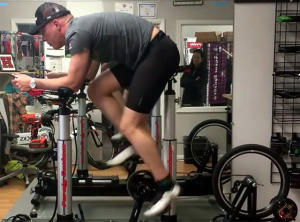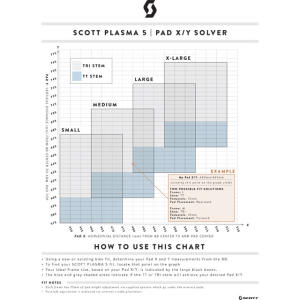I’m going to talk about HX, the most important and underappreciated metric in bike fitting. In truth, I’m not talking to you; I’m talking to your fitter. Still, some Slowtwitchers are interested in the fit process and I guess I’m talking to you too, if you’re one of these.
HX is the horizontal distance between the bottom bracket and the point where the handlebar passes through the stem. It’s a lot like Reach in a bicycle frame, just, in road bike fit HX is a more helpful metric. In tri bike fit either HX or Pad X is helpful. Any fitter who does a lot of fits should become well acquainted and versed in all three horizontal metrics: Reach, Pad X (to pad-rear and pad-center) and HX.
Before we get into the tall weeds, I’m going to step on a toe I’ve resisted bruising for some little while now, but I think it’s just probably time to talk transparently about bike fitting over the past generation. In my opinion there have been two general approaches to bike fit, and consumers can be cynical of each. The first is to tell you what’s wrong, unique or divergent about you, creating a legend about you that convinces you that you’re best off with a custom bicycle. Because you are divergent, the legend goes, you need custom. The cynic would say this is designed to sell custom bikes and in many cases shops and fitters employing the divergent theory of bike fit coincidentally make much or most of their money off this very revenue stream.

The other approach is to tell you precisely the opposite: You’re not sufficiently divergent, damaged, oblong after all, and there is a selection of production bikes that fit you very nicely. The cynic will say this is designed to sell you a production bike and it’s in the best interest of fitters who sell production bikes to adhere to this kind of bike fit methodology. Fair enough.
I adhere to the latter theory. Why? For commercial reasons? No. I adhere to the orthodox rather than the divergent approach because it benefits everyone (except the custom bike seller). It’s not that I’m against custom bikes! It’s that I’m against a custom bike that precisely matches fit coordinates generated by a fitter who does not recognize or value orthodoxy.
Adherence to orthodoxy underpins my fit system (F.I.S.T.). Simply stated, a fitter must value the way very good riders ride their bikes (tri or road) if and when those riders share common aspects, whether in bike position, cadence, tactics, technique, what have you. To ignore common characteristics of better riders is to leave the comfort of orthodoxy and if you’re going to join a cult, best be damned sure your cult is true and the rest of the orthodox world is false.
If a fitter is pulled by the gravitational force of orthodoxy he’ll be much more likely to end a session with you riding a position that you will like, assuming you see a video in profile of you riding in your new position. You will look like a good rider looks. And, your position will work aboard a lot of bikes, because bike makers make bikes that fit orthodox positions. When a fit session ends with you having few or no production bikes available to you without the use of a really arcane front end configuration tortured to make a production bike work, well, what is wrong with you? What congenital disease of the body do you have? Should you be wearing a helmet not just while aboard a bike, but while walking around too? Because you are that physically damaged?
Or, are you in fact reasonably fit, trim and healthy, recognizing that most of us having some sort of limitation? Did you end up in that position not because you are unorthodox, but because your fitter is?

Above is a scale, as you can see, and it’s from one of my fit bikes. It measures HX. As you can also see, the scale gives fitters a lot of leeway in choosing for you a position that yields no bike. It is extremely hard to find a production bike (that is, in road race bikes) if the position you end up in at the end of the fit has that little white arrow on the fit bike pointing to a number that is less than 420mm forward of the BB or greater than 530mm.
But that 11cm is still a large range, yes? No! Let’s take me. I’m 6’2” tall. Would I be happy riding a 48cm bike with a 60mm stem? That’s about what 420mm of HX would yield. Really, I’m looking for a road bike with a frame reach of about 390mm to 400mm with a stem in the neighborhood of 130mm, plus/minus 10mm. That means I’ve got about 30mm of range in HX. The acceptable range of HX for a guy like me is about 490mm to 515mm. My fit better end up inside of that range. If it doesn’t, Lucy (assuming your fitter is named Lucy), you’ve got some splainin to do!
That 30mm range is all there is, for any rider, of any size. What about HY? Not so crucial, because we’ve got “endurance road” geometries, “gran fondo” geometries, we’ve got road race and criterium and all sorts of geometries nowadays and we have headset spacers and stem pitches and whatnot. There are ways aplenty to achieve height or the lack thereof though I pay awfully close attention to HY as well when I fit. Just, when we talk about drivers, what a fitter values, what he relies upon, whether it’s his eye, or body angles, or feedback from the subject, HX is a prime metric or if it’s not it should be. HX guides a fitter toward orthodoxy; it ensures that he won’t disappoint or mislead his subject by reporting there is no production bike that will work; and he inoculates himself against optical illusions or a false sense of safety.
Let’s talk about that false sense. Many of you rely on a “Retül fit”. Many of that many have no real idea what that means. Retül began just as a maker of an innovative tool, an infrared camera that captured a 3D image of body segments in motion. Leads placed on landmarks allowed the tool to calculate both distances and angles formed by these segments. Very cool. And, I might add, Retül, is also based on adherence to orthodoxy.
Retül found that its best way forward was to form its own fit protocol, school and system. Still, the system had at its heart body angles as prime determiners or drivers of position. This is all well and good. Just, body angles are internal measures. HX is longitudinal while body angles do not care whether you are pointed straight ahead or whether you point straight up or are upside down. This isn’t just a Retül issue, but a motion capture issue. Body angles are only of interest to themselves whether the fitter relies on Dartfish or a goniometer or any other method of measuring body angles; the fitter is limited to making sure your knee angle (as an example) comports to orthodoxy but you could be striking that knee angle even if your body is pointed to the moon.
You might reply that this isn't fair, that a proper fitter could marry body angles with a metric that insures that the length of the position is within an acceptable window. So, maybe knee-over-pedal-spindle. Okay, but KOPS is a 4-letter word in bike fit nowadays, for some pretty good reasons.
Hence HX. This is the absolute truth teller of a complete bike’s length, BB to handlebar clamp. The only other element that significantly conspires to add or subtract length is handlebar reach (in tri there are others, such as where the pad sits in space relative to the pursuit bar).
So, that’s it, right? Fitters rely on body angles and… this? In the future maybe. At present, no. What I find in the world of dynamic bike fit is that today’s better fit bikes, like those by Purely Custom and GURU and Shimano, provide this metric, but fitters don’t follow it during the fit. They are naïve to its importance and its utility. (The purpose of this article is to get fitters en masse—whether Retül, Trek Precision Fit, GURU, F.I.S.T.—to pay more attention to this metric.)
Certain fit bikes report stack and reach rather than HX and HY. Fine. There are arcane reasons why HX and HY are more useful to fitters, but then by gosh pay attention to stack and reach while you’re fitting! One problem, though, is that the Retül fit bike, which outputs stack and reach, doesn’t have these metrics written on the bike itself. There is no way to use these metrics during the fit, only to measure them after the fit. One solution would be for Retül to manufacture this bike with a marker, a dot, a pickup, just like those placed on a riders body. Make HX or Reach a landmark. Add this to the harness.
There are a couple of new motion capture systems right now that use the Microsoft Kinect camera as the detector of landmarks. These are wireless systems that rely on reflective dots placed on the body. These systems are probably best poised to currently make this happen, that is, to empower a Retül Müve to report real-time the length of the position during a dynamic fit by placing a reflective dot on the bike. It would require a little programming, but, it would be ironic if a motion capture system not Retül might be the most helpful system to use with Retül’s own fit bike.
Riffing off of this, now HX and HY would be digitized, allowing a fitter to generate real time complete bike solutions during the fit: "You're a Felt FR, size 56cm, 110mm stem, -6° pitch, 15mm of headset dust cover, let's make some changes and see what bike you are then."
Purely Custom and GURU fit bikes both report HX real time during the fit. A fitter keeping his eye glued to HX during the fit is the beneficiary of a lot: It inoculates the fitter from settling on a set of fit coordinates for which there is no bike; it gives his subjects a fighting chance at riding a bike the way good people ride their bikes; and both fitter and subject can rest in whatever comfort comes from a bike and a bike position that looks good and normal. Certainly a handsome position isn’t the goal of the fit, but taken together with positive feedback on comfort and power from the subject, orthodoxy is, to me, the First Commandment of bike fit and HX is the single metric offering the best adherence to orthodoxy.



